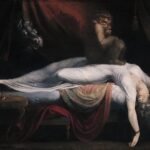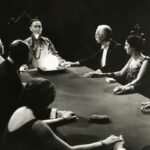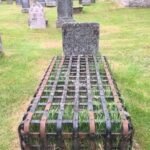The Count of St. Germain or in French Comte de Saint Germain (French pronunciation: [kɔ̃t də sɛ̃ ʒɛʁmɛ̃]; c. 1691 or 1712 – 27 February 1784) was a European adventurer who achieved prominence in European high society of the mid-18th century due to his interest and achievements in science, alchemy, philosophy, and the arts. St. Germain used a variety of names and titles, including the Marquis de Montferrat, Comte Bellamarre, Chevalier Schoening, Count Weldon, Comte Soltikoff, Manuel Doria, Graf Tzarogy, and Prinz Ragoczy. While his real name is unknown, and his birth and background obscure, towards the end of his life he claimed that he was a son of Prince Francis II Rákóczi of Transylvania.
He is said to have made far-fetched claims (such as being 500 years old), leading Voltaire to dub him “The Wonderman”, and that “He is a man who does not die, and who knows everything”. Prince Charles of Hesse-Kassel is recorded as having called him “one of the greatest philosophers
Life and career
Background
The count claimed to be a son of Francis II Rákóczi, the Prince of Transylvania, which could possibly be unfounded. However, this would account for his wealth and fine education. The will of Francis II Rákóczi mentions his eldest son, Leopold George, who was believed to have died at the age of four. The speculation is that his identity was safeguarded as a protective measure against the persecutions of the Habsburg dynasty. At the time of his arrival in Schleswig in 1779, St. Germain told Prince Charles of Hesse-Kassel that he was 88 years old. This would place his birth in 1691 when Francis II Rákóczi was 15 years old.
St. Germain was supposedly educated in Italy by the last of the Medicis, Gian Gastone, his alleged mother’s brother-in-law. He was believed to be a student at the University of Siena. Throughout his adult life, he deliberately spun a confusing web to conceal his actual name and origins, using different pseudonyms in the different places of Europe that he visited.
The Marquis de Crequy declared that St. Germain was an Alsatian Jew, Simon Wolff by name, and was born at Strasbourg about the close of the 17th or the beginning of the 18th century; others insist that he was a Spanish Jesuit named Aymar; and others again intimate that his true title was the Marquis de Betmar, and that he was a native of Portugal. The most plausible theory, however, makes him the natural son of an Italian princess and fixes his birth at San Germano, in Savoy, about the year 1710; his ostensible father being one Rotondo, a tax-collector of that district.
— Phineas Taylor Barnum, The Humbugs of the World, 1886.
Historical figure
He appears to have begun to be known under the title of the Count of St Germain during the early 1740s.
England
According to David Hunter, the count contributed some of the songs to L’incostanza delusa, an opera performed at the Haymarket Theatre in London on all but one of the Saturdays from 9 February to 20 April 1745. Later, in a letter of December of that same year, Horace Walpole mentions Count St. Germain as being arrested in London on suspicion of espionage (this was during the Jacobite rebellion of 1745), but released without charge:
The other day they seized an odd man, who goes by the name of Count St. Germain. He has been here these two years, and will not tell who he is, or whence, but professes [two wonderful things, the first] that he does not go by his right name; and the second that he never had any dealings with any woman – nay, nor with any succedaneum. He sings, plays on the violin wonderfully, composes, is mad, and not very sensible. He is called an Italian, a Spaniard, a Pole; somebody that married a great fortune in Mexico, and ran away with her jewels to Constantinople; a priest, a fiddler, a vast nobleman. The Prince of Wales has had an unsatiated curiosity about him, but in vain. However, nothing has been made out against him; he is released; and, what convinces me that he is not a gentleman, stays here, and talks of his being taken up for a spy.
The Count gave two private musical performances in London in April and May 1749. On one such occasion, Lady Jemima Yorke described how she was “very much entertain’d by him or at him the whole Time – I mean the Oddness of his Manner which it is impossible not to laugh at, otherwise you know he is very sensible & well-bred in conversation”. She continued:
He is an Odd Creature, and the more I see him the more curious I am to know something about him. He is everything with everybody: he talks Ingeniously with Mr Wray, Philosophy with Lord Willoughby, and is gallant with Miss Yorke, Miss Carpenter, and all the Young Ladies. But the Character and Philosopher is what he seems to pretend to, and to be a good deal conceited of: the Others are put on to comply with Les Manieres du Monde, but that you are to suppose his real characteristic; and I can’t but fancy he is a great Pretender in All kinds of Science, as well as that he really has acquired an uncommon Share in some.
Walpole reports that St Germain:
spoke Italian and French with the greatest facility, though it was evident that neither was his language; he understood Polish and soon learnt to understand English and talk it a little […] But Spanish or Portuguese seemed his natural language.
Walpole concludes that the Count was “a man of Quality who had been in or designed for the Church. He was too great a musician not to have been famous if he had not been a gentleman”. Walpole describes the Count as pale, with “extremely black” hair and a beard. “He dressed magnificently, [and] had several jewels” and was clearly receiving “large remittances, but made no other figure”.
France
St. Germain appeared in the French court around 1748. In 1749, he was employed by Louis XV for diplomatic missions.
A mime and English comedian known as Mi’Lord Gower impersonated St. Germain in Paris salons. His stories were wilder than the real count’s (he had advised Jesus, for example). Inevitably, hearsay of his routine got confused with the original.[citation needed]
Giacomo Casanova describes in his memoirs several meetings with the “celebrated and learned impostor”. Of his first meeting, in Paris in 1757, he writes:
The most enjoyable dinner I had was with Madame de Robert Gergi, who came with the famous adventurer, known by the name of the Count de St. Germain. This individual, instead of eating, talked from the beginning of the meal to the end, and I followed his example in one respect as I did not eat, but listened to him with the greatest attention. It may safely be said that as a conversationalist he was unequalled.
St. Germain gave himself out for a marvel and always aimed at exciting amazement, which he often succeeded in doing. He was a scholar, linguist, musician, and chemist, good-looking, and a perfect ladies’ man. For a while he gave them paints and cosmetics; he flattered them, not that he would make them young again (which he modestly confessed was beyond him) but that their beauty would be preserved by means of a wash which, he said, cost him a lot of money, but which he gave away freely. He had contrived to gain the favour of Madame de Pompadour, who had spoken about him to the king, for whom he had made a laboratory, in which the monarch – a martyr to boredom – tried to find a little pleasure or distraction, at all events, by making dyes. The king had given him a suite of rooms at Chambord, and a hundred thousand francs for the construction of a laboratory, and according to St. Germain the dyes discovered by the king would have a materially beneficial influence on the quality of French fabrics.
This extraordinary man, intended by nature to be the king of impostors and quacks, would say in an easy, assured manner that he was three hundred years old, that he knew the secret of the Universal Medicine, that he possessed a mastery over nature, that he could melt diamonds, professing himself capable of forming, out of ten or twelve small diamonds, one large one of the finest water without any loss of weight. All this, he said, was a mere trifle to him. Notwithstanding his boastings, his bare-faced lies, and his manifold eccentricities, I cannot say I thought him offensive. In spite of my knowledge of what he was and in spite of my own feelings, I thought him an astonishing man as he was always astonishing me.
Dutch Republic
In March 1760, at the height of the Seven Years’ War, St. Germain travelled to The Hague. In Amsterdam, he stayed at the bankers Adrian and Thomas Hope and pretended he came to borrow money for Louis XV with diamonds as collateral. He assisted Bertrand Philip, Count of Gronsveld starting a porcelain factory in Weesp as furnace and colour specialist. St. Germain tried to open peace negotiations between Britain and France with the help of Duke Louis Ernest of Brunswick-Lüneburg. British diplomats concluded that St. Germain had the backing of the Duc de Belle-Isle and possibly of Madame de Pompadour, who were trying to outmanoeuvre the French Foreign Minister, the pro-Austrian Duc de Choiseul. However, Britain would not treat with St. Germain unless his credentials came directly from the French king. The Duc de Choiseul convinced Louis XV to disavow St. Germain and demand his arrest. Count Bentinck de Rhoon, a Dutch diplomat, regarded the arrest warrant as internal French politicking, in which Holland should not involve itself. However, a direct refusal to extradite St. Germain was also considered impolitic. De Rhoon, therefore, facilitated the departure of St. Germain to England with a passport issued by the British Ambassador, General Joseph Yorke. This passport was made out “in blank”, allowing St. Germain to travel in May 1760 from Hellevoetsluis to London under an assumed name, showing that this practice was officially accepted at the time.
From St. Peterburg, St. Germain travelled to Berlin, Vienna, Milan, Ubbergen, and Zutphen (June 1762),[unreliable source?] Amsterdam (August 1762), Venice (1769), Livorno (1770), Neurenberg (1772), Mantua (1773), The Hague (1774), and Bad Schwalbach.
Death
In 1779, St. Germain arrived in Altona in Schleswig, where he made an acquaintance with Prince Charles of Hesse-Kassel, who also had an interest in mysticism and was a member of several secret societies. The count showed the Prince several of his gems and he convinced the latter that he had invented a new method of colouring cloth. The Prince was impressed and installed the Count in an abandoned factory at Eckernförde he had acquired especially for the Count, and supplied him with the materials and cloths that St. Germain needed to proceed with the project. The two met frequently in the following years, and the Prince outfitted a laboratory for alchemical experiments in his nearby summer residence Louisenlund, where they, among other things, cooperated in creating gemstones and jewelry. The prince later recounts in a letter that he was the only person in whom the count truly confided. He told the prince that he was the son of the Transylvanian Prince Francis II Rákóczi, and that he had been 88 years of age when he arrived in Schleswig.
The count died in his residence in the factory on 27 February 1784, while the prince was staying in Kassel, and the death was recorded in the register of the St. Nicolai Church in Eckernförde. He was buried 2 March and the cost of the burial was listed in the accounting books of the church the following day. The official burial site for the count is at Nicolai Church (German St. Nicolaikirche) in Eckernförde. He was buried in a private grave. On 3 April the same year, the mayor and the city council of Eckernförde issued an official proclamation about the auctioning off of the count’s remaining effects in case no living relative would appear within a designated time period to lay claim on them. Prince Charles donated the factory to the crown and it was afterward converted into a hospital.
Jean Overton Fuller found, during her research, that the count’s estate upon his death was a packet of paid and receipted bills and quittances, 82 Reichsthalers and 13 shillings (cash), 29 various groups of items of clothing (this includes gloves, stockings, trousers, shirts, etc.), 14 linen shirts, eight other groups of linen items, and various sundries (razors, buckles, toothbrushes, sunglasses, combs, etc.). No diamonds, jewels, gold, or any other riches were listed, nor were kept cultural items from travels, personal items (like his violin), or any notes of correspondence.










